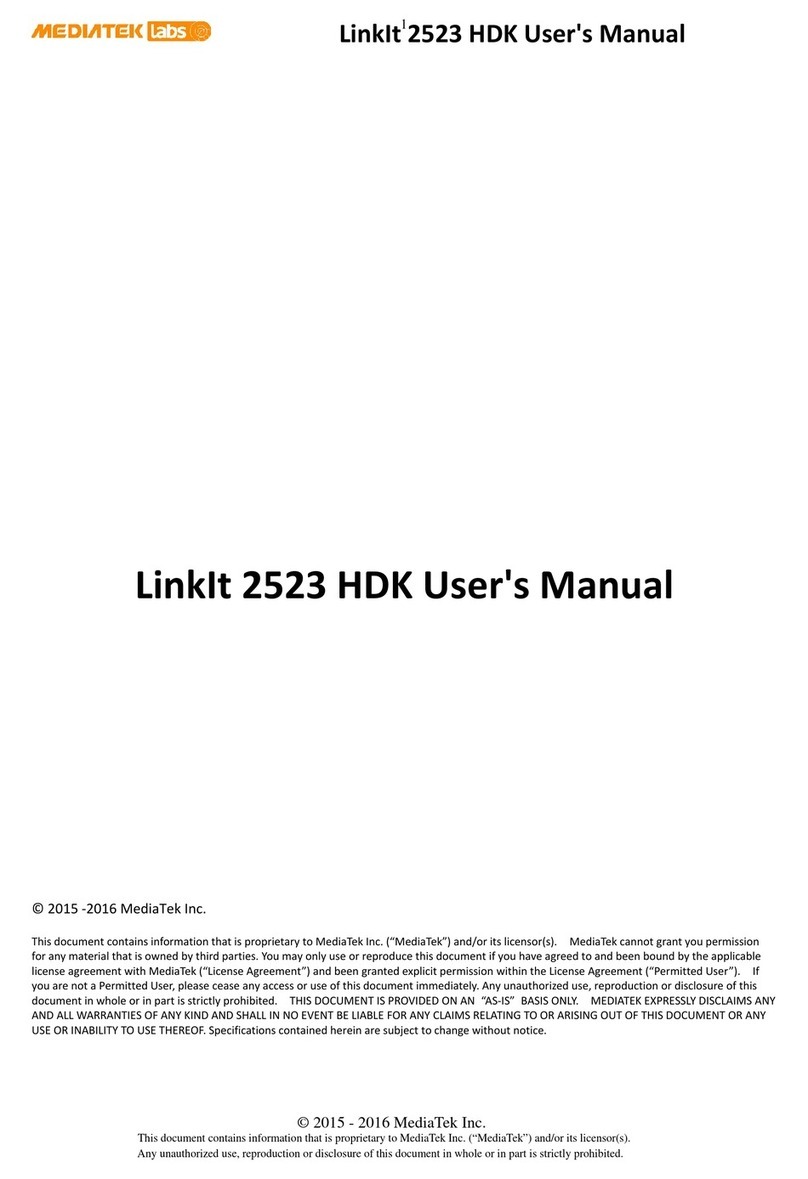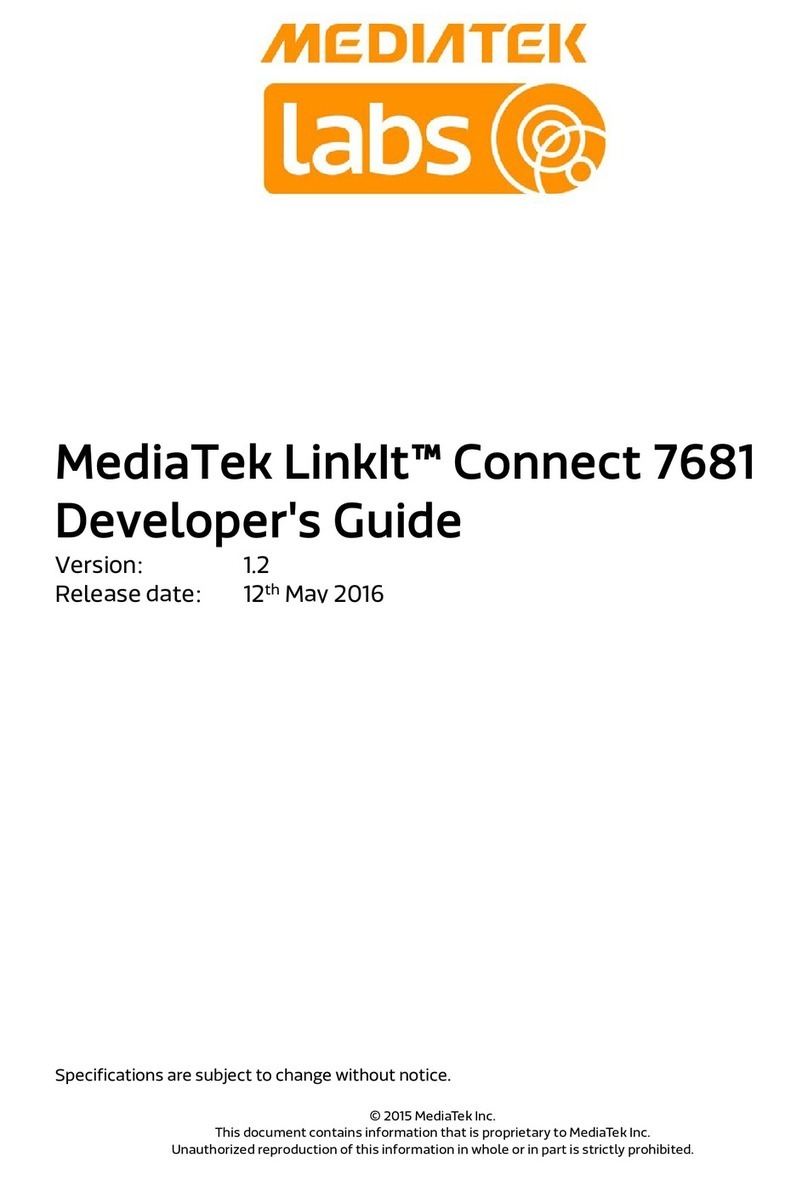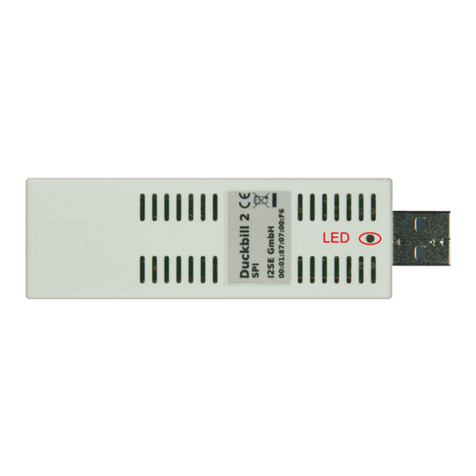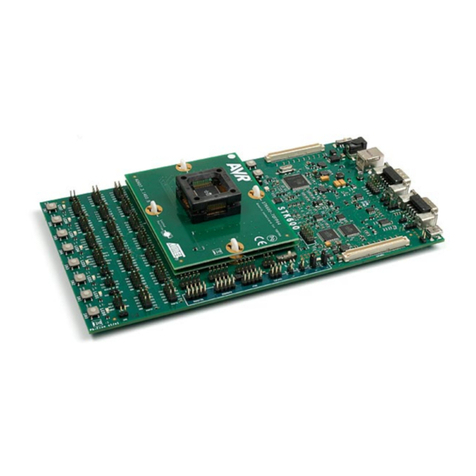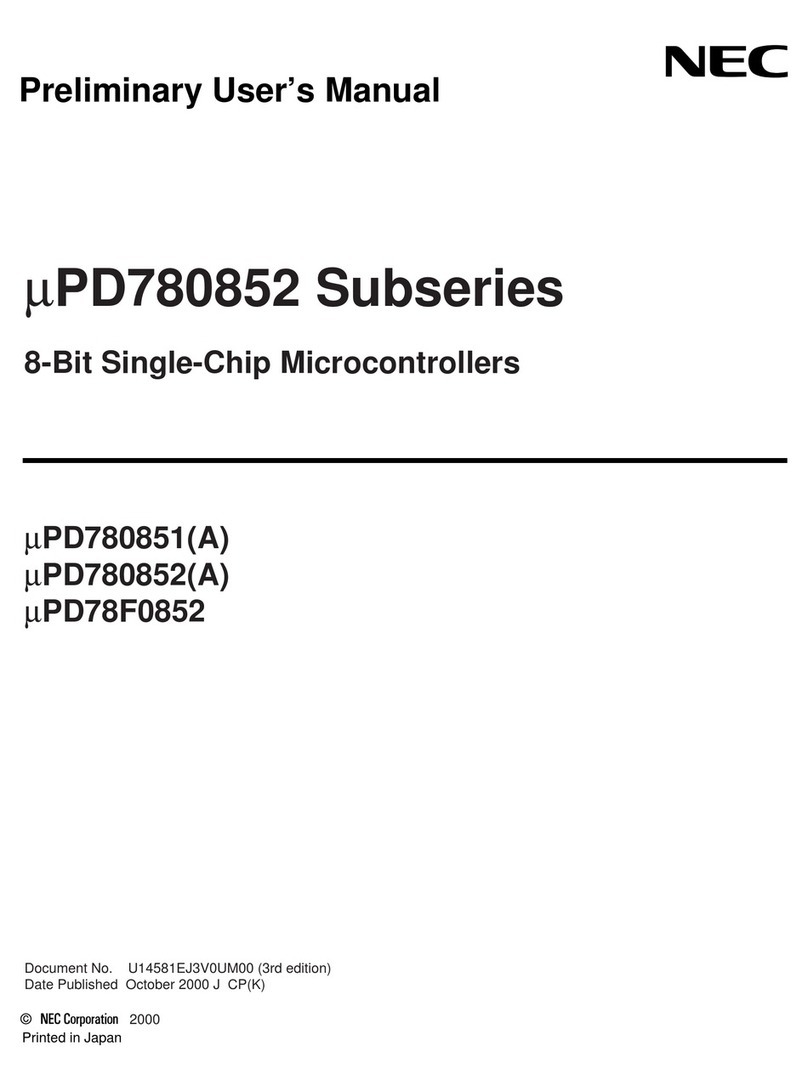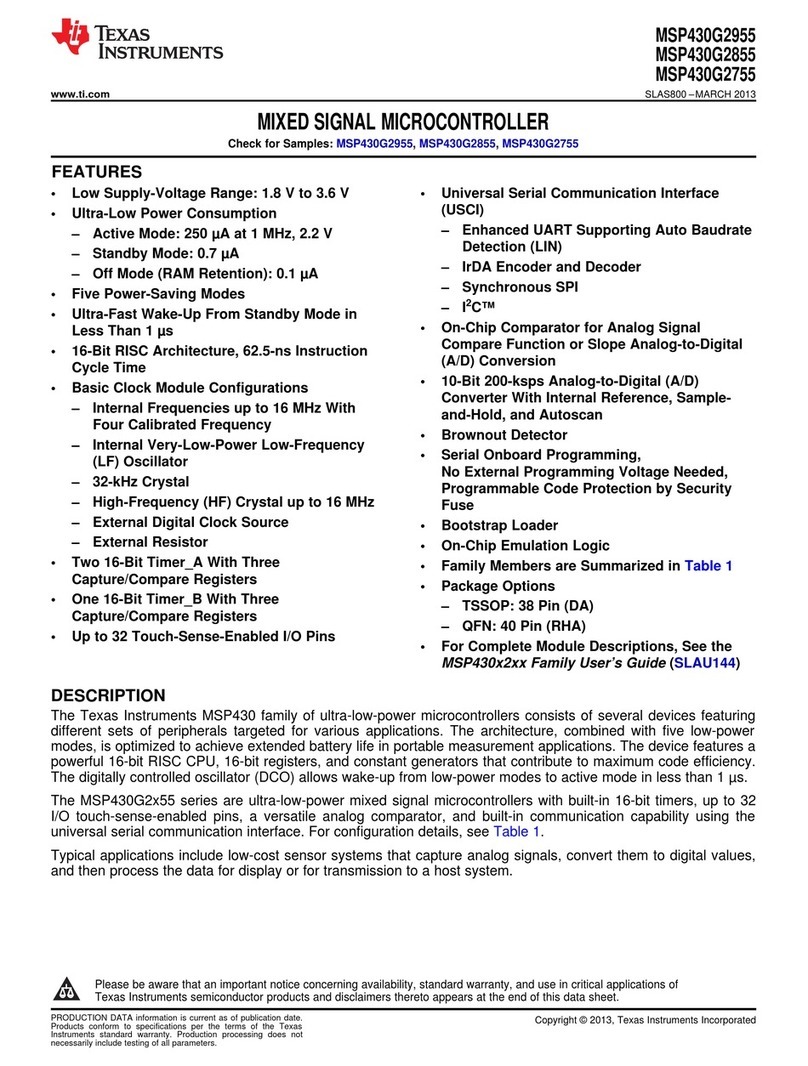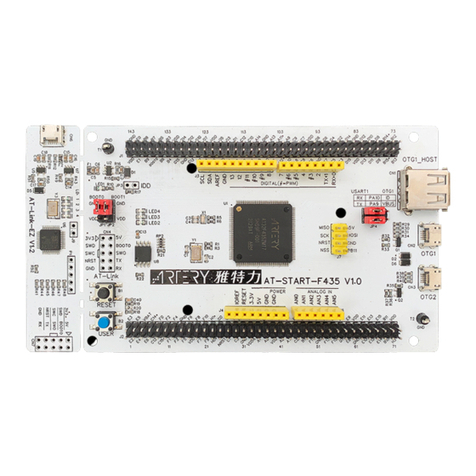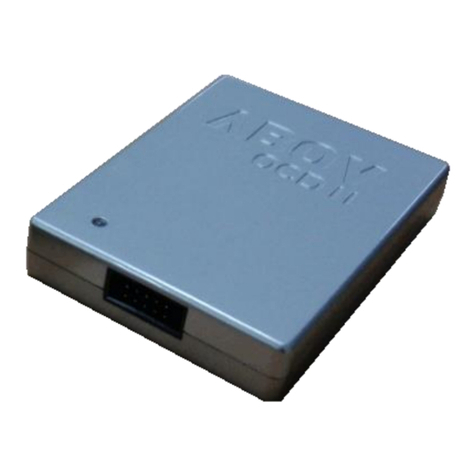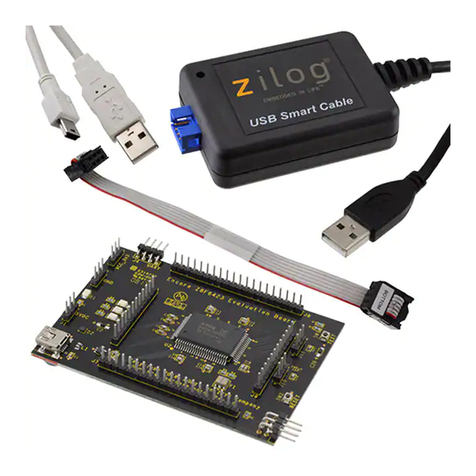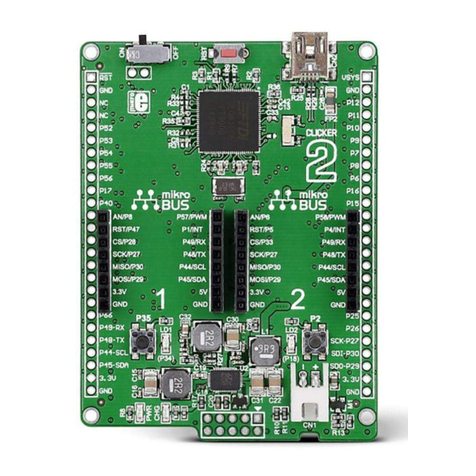Mediatek Labs LinkIt 7687 HDK V30 User manual

LinkIt 7687 HDK V30 User's Guide
Version: 1.3
Release date: 30 June 2016
© 2015 - 2016 MediaTek Inc.
This document contains information that is proprietary to MediaTek Inc. (“MediaTek”) and/or its licensor(s). MediaTek cannot grant you
permission for any material that is owned by third parties. You may only use or reproduce this document if you have agreed to and been
bound by the applicable license agreement with MediaTek (“License Agreement”) and been granted explicit permission within the License
Agreement (“Permitted User”). If you are not a Permitted User, please cease any access or use of this document immediately. Any
unauthorized use, reproduction or disclosure of this document in whole or in part is strictly prohibited. THIS DOCUMENT IS PROVIDED ON AN
“AS-IS” BASIS ONLY. MEDIATEK EXPRESSLY DISCLAIMS ANY AND ALL WARRANTIES OF ANY KIND AND SHALL IN NO EVENT BE LIABLE FOR ANY
CLAIMS RELATING TO OR ARISING OUT OF THIS DOCUMENT OR ANY USE OR INABILITY TO USE THEREOF. Specifications contained herein are
subject to change without notice.

LinkIt 7687 HDK V30 User's Guide
© 2015 – 2016 MediaTek Inc. Page 1 of 23
This document contains information that is proprietary to MediaTek Inc. (“MediaTek”) and/or its licensor(s).
Any unauthorized use, reproduction or disclosure of this document in whole or in part is strictly prohibited.
Document Revision History
Revision Date Description
1.0 31 March 2016 Initial version.
1.1 2 May 2016 Added power domain information. Refine the output binary file
name.
1.2 17 May 2016 Added CMSIS-DAP firmware update procedure.
1.3 30 June 2016 Refine the Get started section and pull-up resister.

LinkIt 7687 HDK V30 User's Guide
© 2015 – 2016 MediaTek Inc. Page 2 of 23
This document contains information that is proprietary to MediaTek Inc. (“MediaTek”) and/or its licensor(s).
Any unauthorized use, reproduction or disclosure of this document in whole or in part is strictly prohibited.
Table of contents
1. Introduction........................................................................................................................................ 4
2. Get started with the HDK .................................................................................................................... 5
2.1. Configuring the LinkIt 7687 HDK.........................................................................................................5
2.2. Installing the LinkIt 7687 HDK drivers on Microsoft Windows...........................................................6
2.3. Configuring the HDK flash mode ........................................................................................................7
2.4. Downloading the image using the LinkIt 7687 HDK as a removable storage .....................................8
3. Hardware Features.............................................................................................................................. 9
4. Hardware Feature Configuration ....................................................................................................... 10
4.1. Microcontroller.................................................................................................................................10
4.2. Power supply ....................................................................................................................................10
4.3. LEDs .................................................................................................................................................. 11
4.4. Buttons .............................................................................................................................................12
4.5. Extension connectors ....................................................................................................................... 13
4.6. RTC....................................................................................................................................................18
4.7. RF connections..................................................................................................................................18
4.8. CMSIS-DAP Firmware update procedure..........................................................................................19
5. Schematics (V30)............................................................................................................................... 20

LinkIt 7687 HDK V30 User's Guide
© 2015 – 2016 MediaTek Inc. Page 3 of 23
This document contains information that is proprietary to MediaTek Inc. (“MediaTek”) and/or its licensor(s).
Any unauthorized use, reproduction or disclosure of this document in whole or in part is strictly prohibited.
Lists of tables and figures
Table 1. Jumper settings for system power input through USB connection.........................................................10
Table 2. System power input from AA or AAA battery jumpers ...........................................................................11
Table 3. GPIO pins to activate the LEDS ................................................................................................................12
Table 4. GPIO pin multi function definition ..........................................................................................................13
Figure 1. Top view of the LinkIt 7687 HDK..............................................................................................................5
Figure 2. COM port associated with the LinkIt 7687 HDK.......................................................................................7
Figure 3. New removable storage detected............................................................................................................8
Figure 4. Power up the HDK using an AA or AAA Battery (J21).............................................................................11
Figure 5. On-board LEDs........................................................................................................................................12
Figure 6. Arduino and 8-pin extension connector ................................................................................................13
Figure 7. Locations of I2C pull-up resistors ...........................................................................................................18
Figure 8. Location of the components C93 and C94 .............................................................................................19

LinkIt 7687 HDK V30 User's Guide
© 2015 – 2016 MediaTek Inc. Page 4 of 23
This document contains information that is proprietary to MediaTek Inc. (“MediaTek”) and/or its licensor(s).
Any unauthorized use, reproduction or disclosure of this document in whole or in part is strictly prohibited.
1. Introduction
MediaTek LinkIt™ for real-time operating system (RTOS) is a low-cost and easy to use Internet of Things (IoT)
development platform to design, prototype, evaluate and implement IoT projects. The platform supports LinkIt™
76x7 hardware development kit (HDK) by SAC. This user manual provides required knowledge on features of the
HDK, including the pins, communication interfaces, core microcontroller unit (MCU) description, the networking
capabilities and how to use them through the host driver. The HDK includes MediaTek MT76x7 chipset which is
based on ARM Cortex-M4 with floating point MCU in QFN68 package. It enables rich connectivity features,
communication with cloud services and real-time control. LinkIt 76x7 HDK is pin compatible with Arduino UNO R3.
MT76x7 product portfolio includes MT7687F, MT7697, and MT7697D. The examples in the document are carried
on MT7687F chipset and could be applied to any MT76x7 based HDK.
The LinkIt 7687 HDK supports ARM mbed IoT Device Platform for more convenient debugging and binary code
download operations.
The following features are available:
•Mass storage device (MSD) programmer.
oThe LinkIt 7687 HDK has three binary files for bootloader, Wi-Fi and FreeRTOS. The MSD
programmer enables to update the FreeRTOS binary file only.
•CMSIS-DAP (Coresight Debug Access Port (DAP)) Debug Interface.
oA firmware debug interface similar to ST-link or J-link. It enables debugging a target project or
downloading a binary to the flash storage of the device.
•Virtual Serial Port.
oSupports UART functionality, such as transferring log information from the HDK.
These features are used to download and debug the project.

LinkIt 7687 HDK V30 User's Guide
© 2015 – 2016 MediaTek Inc. Page 5 of 23
This document contains information that is proprietary to MediaTek Inc. (“MediaTek”) and/or its licensor(s).
Any unauthorized use, reproduction or disclosure of this document in whole or in part is strictly prohibited.
2. Get started with the HDK
Before commencing the application development, you need to configure the development platform.
2.1. Configuring the LinkIt 7687 HDK
LinkIt 7687 HDK includes a main board and a MT7687F stamp module. The MT7687F stamp module is mounted on
the main board. The top view of the main board is shown in Figure 1.
Figure 1. Top view of the LinkIt 7687 HDK
The description of pins (Figure 1) and their functionality is provided below.
1) CON5 is a USB connector to debug through UART, transmit and receive a signal and supply power from the
PC. The USB connectivity with the PC is supported by the on-board MK20DX128VFM5.
•Set the jumpers J23, J26, J27and J30 on, if the board is powered using the USB connector.
2) Press S4 to wake up the system from the RTC mode.
3) S5 enables the external interrupt (configured at GPIO0), see section 4.4, “Buttons” for more details.
4) Press S1 to reset the system.
5) JP33 enables the board to support RTC interrupt mode, if the jumper pins 1 and 2 are connected.
6) J25 sets the flash mode (see section 2.3, “Configuring the HDK flash mode”).
7) Wi-Fi Antenna is a PCB antenna. MT7687F stamp module is by default connected to the PCB antenna to
transmit and receive RF signals.
The default configuration of the LinkIt 7687 HDK support the following functionality:
1) Power supply - attach a micro-USB connector to the CON5.
CON5
J30
J27
J28
Left to Right
S4(RTC_INT)
S5(EINT)
S1(RST) J24 J23 J26 JP33 J25(FLASH MODE) SMA Connector
for Wi-Fi
1 2 3

LinkIt 7687 HDK V30 User's Guide
© 2015 – 2016 MediaTek Inc. Page 6 of 23
This document contains information that is proprietary to MediaTek Inc. (“MediaTek”) and/or its licensor(s).
Any unauthorized use, reproduction or disclosure of this document in whole or in part is strictly prohibited.
2) Flash mode - Recovery mode.
3) Support RTC interrupt.
4) Clock source - 32.768kHz source crystal clock for the RTC mode or external clock operating on 32.768 kHz.
5) XTAL - 40MHz.
6) RTC mode - supported.
The hardware settings of the stamp module are shown below:
1) XTAL - 40MHz.
2) Clock source - 32.768kHz source crystal clock for the RTC mode or external clock operating on 32.768 kHz.
3) RTC mode - supported.
4) Flash mode - Normal mode.
2.2. Installing the LinkIt 7687 HDK drivers on Microsoft Windows
To configure the LinkIt 7687 HDK:
1) Connect the HDK to the computer using a micro-USB cable.
2) Download and install mbed Windows serial port driver from here. Open Windows Control Panel then
click System and:
•On Windows 7 and 8, click Device Manager.
•On Windows XP, click the Hardware tab and then Device Manager.
3) In Device Manager, navigate to Ports (COM & LPT) (see Figure 2).
4) A new COM device should appear under Ports (COM & LPT) in Device Manager, as shown in Figure 2.
Note the COMx port number of the serial communication port, this information is needed to send
command and receive logs from the COM port. Virtual COM port is connected to the board through
the UART1 of the chipset, see section 4.5,“Extension connectors”. The mbed Serial Port (UART1)is
applied to flash the board and log the outputs.

LinkIt 7687 HDK V30 User's Guide
© 2015 – 2016 MediaTek Inc. Page 7 of 23
This document contains information that is proprietary to MediaTek Inc. (“MediaTek”) and/or its licensor(s).
Any unauthorized use, reproduction or disclosure of this document in whole or in part is strictly prohibited.
Figure 2. COM port associated with the LinkIt 7687 HDK
2.3. Configuring the HDK flash mode
The LinkIt 7687 HDK is embedded with 2MB flash memory. The boot options are either from the Flash memory or
from the UART port.
To update the firmware on the LinkIt 7687 HDK:
1) Set the jumper J25 to FLASH Recovery mode, as shown in Figure 1. The jumpers J23, J26, J27 and J30
should be on.
•In this mode, if the power is on, the board will load ROM code and start the ATE Daemon or Firmware
Upgrade Daemon according to the MT76x7 Flash Tool’s behavior on the PC. A message “ccc” is sent

LinkIt 7687 HDK V30 User's Guide
© 2015 – 2016 MediaTek Inc. Page 8 of 23
This document contains information that is proprietary to MediaTek Inc. (“MediaTek”) and/or its licensor(s).
Any unauthorized use, reproduction or disclosure of this document in whole or in part is strictly prohibited.
to the UART1 port of the chipset and the code is uploaded to the embedded flash memory
through UART1.
2) Connect the board to the computer using a micro-USB cable.
The development board should now be connected to the PC, as shown in Figure 1.
To run the project on the LinkIt 7687 HDK:
1) Set the jumper J25 off to switch to FLASH Normal mode. The jumpers J23, J26, J27 and J30 should be
on.
•In this mode, if the power is on, the board will load firmware from the flash and reboot.
2) Connect the board to a computer using a micro-USB cable.
The development board should now be connected to the PC, as shown in Figure 1.
2.4. Downloading the image using the LinkIt 7687 HDK as a removable
storage
To update the FreeRTOS binary only (example project binary: mt7687_iot_sdk.bin), use the HDK as a mass
storage device according to the following steps:
1) Set the HDK to FLASH Recovery mode.
2) Power up the board with a micro-USB cable.
3) Navigate to Computer on your PC to check if a new mass storage named MT76x7 is available
under Removable Disk, as shown in Figure 3.
4) Open the MT76x7 removable storage, then drag and drop the binary mt7687_iot_sdk.bin to
complete downloading the image.
5) Disconnect, set the jumper to FLASH Normal mode, and then reconnect the board to run your
application.
Figure 3. New removable storage detected

LinkIt 7687 HDK V30 User's Guide
© 2015 – 2016 MediaTek Inc. Page 9 of 23
This document contains information that is proprietary to MediaTek Inc. (“MediaTek”) and/or its licensor(s).
Any unauthorized use, reproduction or disclosure of this document in whole or in part is strictly prohibited.
3. Hardware Features
This section provides the main supported features of the LinkIt 7687 HDK. The detailed description of the features
is provided in the upcoming sections.
•IEEE 802.11bgn Wireless Connectivity Single Chip with QFN68 package.
•Arduino UNO Revision 3 pin compatible and an eight pin extension connector.
•The I/Os on MT7687F are 3.3V compatible.
•Support for FreeRTOS.
•Flexible on-board power supply
oUSB with power (V
Bus, 5V).
oExternal V
IN (1.8~3.2V).
•Ten LEDs
oUART communication LEDs (D9, D10), power LEDs (D6, D5), user LEDs
(D11, D12, D13, D14, D15).
•Three push buttons
oSystem Reset.
oReal Time Clock (RTC) Interrupt.
oExternal Interrupt.
•XTAL (Crystal Oscillator)
o40MHz source clock support with low power consumption in idle mode.
o32.768kHz clock for the RTC mode or external 32.768kHz mode.
•USB re-enumeration capability: two different interfaces supported on the same USB.
oCMSIS-DAP USB.
oVirtual COM port UART through USB on PC.
•On-board chip antenna with U.FL for conducted testing.
•Micro USB connector for power and debug connections.
•Headers for current measurement.

LinkIt 7687 HDK V30 User's Guide
© 2015 – 2016 MediaTek Inc. Page 10 of 23
This document contains information that is proprietary to MediaTek Inc. (“MediaTek”) and/or its licensor(s).
Any unauthorized use, reproduction or disclosure of this document in whole or in part is strictly prohibited.
4. Hardware Feature Configuration
4.1. Microcontroller
MT7687F features an ARM Cortex-M4 with floating point processor, which is the most energy efficient ARM
processor available.
MT7687F provides low power consumption embedded architecture and it’s optimized for various types of
applications in home automation, smart grid, handheld devices, personal medical devices and industrial control
that have lower data rates, and transmit or receive data on an infrequent basis.
4.2. Power supply
LinkIt 7687 HDK supports two types of power supply.
1) Power up with a micro-USB connector.
An on-board switching regulator provides voltage of 3.3V for the LinkIt 7687 HDK based on MT7687F, if the power
is supplied from an on-board micro-USB connector CON5 (Figure 1). This supply can be isolated from the
switching regulator using the jumpers. Note that the jumpers J27, J30, J23 and J26 are required to be set on.
More details on the jumpers can be found in Table 1.
Table 1. Jumper settings for system power input through USB connection
Jumper Usage Comments
J27 3.3V power supply Use micro-USB connector supporting 3.3V
power source.
J30 Current measurement Measures the current flow in MT7687F.
J23 RTC3V3 power supply Use micro-USB connector supporting RTC
3V3 power.
J26 Current measurement in RTC
mode
Measures the current flow in the MT7687F
RTC mode.
2) Power up using an AA or AAA battery.
•Connect an external AA battery to battery pin header (J21) to supply power to the system, as shown in
Figure 4. When use AA battery ,please plug the USB to micro-USB connector CON5 (Figure 1).Note that
the jumpers J28, J30, J24 and J26 are required to be set on. More details on the jumpers can be found
in Table 2.

LinkIt 7687 HDK V30 User's Guide
© 2015 – 2016 MediaTek Inc. Page 11 of 23
This document contains information that is proprietary to MediaTek Inc. (“MediaTek”) and/or its licensor(s).
Any unauthorized use, reproduction or disclosure of this document in whole or in part is strictly prohibited.
Figure 4. Power up the HDK using an AA or AAA Battery (J21)
Table 2. System power input from AA or AAA battery jumpers
Jumper Usage Comments
J28 3.3V power supply Use AA or AAA battery source
supporting 3.3V power.
J30 Current measurement Measures the current flow in
MT7687F.
J24
RTC 3V3 power supply
Use AA or AAA battery source
supporting RTC 3V3 power.
J26
Current measurement in RTC mode
Measures the current flow in the
MT7687F RTC mode.
4.3. LEDs
The LinkIt 7687 HDK has onboard LEDs associated with different functionalities of the board (Figure 5).
1) D6 indicates the power rail 5V is on.
2) D5 indicates the power rail 3.3V is on.
3) D9 (UART Tx) indicates the UART1 transmission is in use (blink, if there is traffic).
4) D10 (UART Rx) indicates the UART1 receiving is in use (blink, if there is traffic).
2xAA or 2xAAA

LinkIt 7687 HDK V30 User's Guide
© 2015 – 2016 MediaTek Inc. Page 12 of 23
This document contains information that is proprietary to MediaTek Inc. (“MediaTek”) and/or its licensor(s).
Any unauthorized use, reproduction or disclosure of this document in whole or in part is strictly prohibited.
Figure 5.On-board LEDs
5) D11, D12, D13, D14, and D15 are LEDs assigned for user interaction. All LEDs are high active (Figure 5).
GPIO pins to activate the LEDs are shown in Table 3.
Table 3. GPIO pins to activate the LEDS
LED GPIO
D11 GPIO31
D12 GPIO35
D13 GPIO34
D14 GPIO33
D15 GPIO6
4.4. Buttons
The LinkIt 7687 HDK is equipped with buttons with the following functionality. The push buttons are shown in
Figure 1.
1) System reset button (S1) resets the LinkIt 7687 HDK.
D15
D14
D13
D12
D6 D5
D9 (UART Tx)
D10 (UART Rx)

LinkIt 7687 HDK V30 User's Guide
© 2015 – 2016 MediaTek Inc. Page 13 of 23
This document contains information that is proprietary to MediaTek Inc. (“MediaTek”) and/or its licensor(s).
Any unauthorized use, reproduction or disclosure of this document in whole or in part is strictly prohibited.
2) RTC interrupt mode button (S4). When the system is in the RTC mode, push the button to wake up the
system.
3) External interrupt button (S5). Users can configure GPIO0 as an external interrupt pin. Press the button to
wake up the system from the sleep mode.
4.5. Extension connectors
The LinkIt 7687 HDK provides similar pin-out to Arduino UNO with extension connectors (J32 to J36) for various
sensor and device connectivity, as shown in Figure 6.
Figure 6. Arduino and 8-pin extension connector
The board has 28 GPIOs multiplexed with other interfaces. Depending on the use case, user can configure each I/O
functionality.
Table 4. GPIO pin multi function definition
J36
J35
J34 J32
J33
Ref
J36
Signal
J35
Signal
J34
Signal
1
GPIO4
GPIO35
GPIO27
2
GPIO5
GPIO34
GPIO28
3
GPIO7
GPIO33
NA
4
GPIO24
GPIO6
GND
5
GPIO25
GPIO1
GPIO31
6
GPIO26
GPIO0
GPIO30
7
GPIO2
GPIO37
GPIO29
8
GPIO3
GPIO36
GPIO32
9
GPIO39
10
GPIO38
Ref
J32
Signal
J33
Signal
1
NA
GPIO60
2
3.3V
GPIO59
3
Reset
GPIO58
4
3.3V
GPIO57
5
5V
GPIO28
6
GND
GPIO27
7
GND
8
NA
Pin alias Name Direction Description
GPIO0 UART1_RTS_CM4 O UART1 RTS (Cortex-M4)
GPIO[0] I/O General purpose input, output
PWM[0] I/O Pulse-width-modulated output
EINT[0] I External interrupt
GPIO1 UART1_CTS_CM4 I UART1 CTS (Cortex-M4)
GPIO[1] I/O General purpose input, output

LinkIt 7687 HDK V30 User's Guide
© 2015 – 2016 MediaTek Inc. Page 14 of 23
This document contains information that is proprietary to MediaTek Inc. (“MediaTek”) and/or its licensor(s).
Any unauthorized use, reproduction or disclosure of this document in whole or in part is strictly prohibited.
PWM[1] O Pulse-width-modulated output
EINT[1] I External interrupt
GPIO2 UART1_RX_CM4 I UART1 RX (Cortex-M4)
SWD_CLK O Cortex-M4 SWD debug port
GPIO[2] I/O General purpose input, output
PWM[23] O Pulse-width-modulated output
WIC[0] I External interrupt
GPIO3 UART1_TX_CM4 O UART1 TX (Cortex-M4)
SWD_DIO I/O Cortex-M4 SWD debug port
GPIO[3] I/O General purpose input, output
PWM[24] O Pulse-width-modulated output
EINT[2] I External interrupt
PULSE_CNT I Pulse counter
GPIO4 SPI_DATA0_EXT * I/O External flash interface
GPIO[4] I/O General purpose input, output
PWM[2] O Pulse-width-modulated output
EINT[3] I External interrupt
GPIO5 SPI_DATA1_EXT * O External flash interface
GPIO[5] I/O General purpose input, output
PWM[3] O Pulse-width-modulated output
EINT[4] I External interrupt
GPIO6 SPI_CS_1_M_CM4 O SPI master chip select 1
GPIO[6] I/O General purpose input, output
PWM[4] O Pulse-width-modulated output
EINT[5] I External interrupt
GPIO7 SPI_CS_0_M_CM4 O SPI master chip select 0
SPI_CS_EXT * O External flash interface
GPIO[7] I/O General purpose input, output
PWM[5] O Pulse-width-modulated output
EINT[6] I External interrupt
GPIO24 SPI_MOSI_M_CM4 O SPI master MOSI
SPI_DATA2_EXT * I/O External flash interface
I2C1_CLK I/O I2C1 CLK
GPIO[24] I/O General purpose input, output
PWM[25] O Pulse width modulation
GPIO25 SPI_MISO_M_CM4 I SPI master MISO
SPI_DATA3_EXT * I/O External flash interface
I2C1_DATA I/O I2C1 DATA
GPIO[25] I/O General purpose input, output
PWM[26] O Pulse width modulation

LinkIt 7687 HDK V30 User's Guide
© 2015 – 2016 MediaTek Inc. Page 15 of 23
This document contains information that is proprietary to MediaTek Inc. (“MediaTek”) and/or its licensor(s).
Any unauthorized use, reproduction or disclosure of this document in whole or in part is strictly prohibited.
FRAME_SYNC * I 3DD synchronization
WIC[1] I External interrupt
GPIO26 SPI_SCK_M_CM4 O SPI master SCK
SPI_CLK_EXT * O External flash interface
I2S_TX O I2S master TX
GPIO[26] I/O General purpose input, output
PWM[27] O Pulse width modulation
GPIO27 SWD_DIO I/O Cortex-M4 SWD debug port
I2C0_CLK(1) O I2C0 CLK
GPIO[27] I/O General purpose input, output
PWM[28] O Pulse width modulation
PULSE_CNT I Pulse counter input
WIC[2] I External interrupt
GPIO28 SWD_CLK I Cortex-M4 SWD debug port
I2C0_DATA(1) O I2C0 DATA
GPIO[28] I/O General purpose input, output
PWM[29] O Pulse width modulation
GPIO29 I2S_MCLK_S O I2S MCLK slave
SPI_MOSI_S_CM4 I SPI slave MOSI (Cortex-M4)
SPI_MOSI_M_CM4 O SPI master MOSI
GPIO[29] I/O General purpose input, output
PWM[30] O Pulse width modulation
WIC[3] I External interrupt
GPIO30 SPI_MISO_S_CM4 O SPI slave MISO (Cortex-M4)
SPI_MISO_M_CM4 I SPI master MISO
I2S_FS I I2S slave FS
GPIO[30] I/O General purpose input, output
PWM[31] O Pulse width modulation
GPIO31 I2S_TX O I2S TX
SPI_SCK_S_CM4 I SPI slave SCK (Cortex-M4)
SPI_SCK_M O SPI master SCK
I2S_RX I I2S slave RX
GPIO[31] I/O General purpose input, output
PWM[32] O Pulse width modulation
GPIO32 SPI_CS_0_S_CM4 I SPI slave CS (Cortex-M4)
SPI_CS_0_M O SPI master CS
I2S_BCLK I I2S BCLK slave
GPIO[32] I/O General purpose input, output
PWM[33] O Pulse width modulation

LinkIt 7687 HDK V30 User's Guide
© 2015 – 2016 MediaTek Inc. Page 16 of 23
This document contains information that is proprietary to MediaTek Inc. (“MediaTek”) and/or its licensor(s).
Any unauthorized use, reproduction or disclosure of this document in whole or in part is strictly prohibited.
WIC[4] I External interrupt
GPIO33 SWD_DIO I/O Cortex-M4 SWD debug port
IR_TX O IrDA TX
GPIO[33] I/O General purpose input, output
PWM[34] O Pulse width modulation
PULSE_CNT I Pulse counter
WIC[5] I External interrupt
GPIO34 SWD_CLK I Cortex-M4 SWD debug port
IR_RX I IrDA RX
GPIO[34] I/O General purpose input, output
PWM[35] O Pulse width modulation
FRAME_SYNC * I 3DD synchronization
WIC[6] I External interrupt
GPIO35 UART_DBG_CM4 O UART DBG TX (Cortex-M4)
GPIO[35] I/O General purpose input, output
PWM[18] O Pulse-width-modulated output
GPIO36 UART2_RX_CM4 I UART2 RX (Cortex-M4)
GPIO[36] I/O General purpose input, output
PWM[19] O Pulse-width-modulated output
WIC[7] I External interrupt
GPIO37 UART2_TX_CM4 O UART2 TX (Cortex-M4)
GPIO[37] I/O General purpose input, output
PWM[20] O Pulse-width-modulated output
EINT[20] I External interrupt
GPIO38 UART2_RTS_CM4 O UART2 RTS (Cortex-M4)
GPIO[38] I/O General purpose input, output
PWM[21] O Pulse-width-modulated output
EINT[21] I External interrupt
SWD_DIO I/O Cortex-M4 SWD debug port
GPIO39 UART2_CTS_CM4 O UART2 CTS (Cortex-M4)
[Reserved] [Reserved]
GPIO[39] I/O General purpose input, output
PWM[22] O Pulse-width-modulated output
PULSE_COUNT * I Pulse counter
EINT[22] I External interrupt
SWD_CLK I Cortex-M4 SWD debug port
GPIO57 PCM_CLK I/O PCM interface for Bluetooth
GPIO[57] I/O General purpose input, output
PWM[36] O Pulse-width-modulated output
WIC[8] I External interrupt

LinkIt 7687 HDK V30 User's Guide
© 2015 – 2016 MediaTek Inc. Page 17 of 23
This document contains information that is proprietary to MediaTek Inc. (“MediaTek”) and/or its licensor(s).
Any unauthorized use, reproduction or disclosure of this document in whole or in part is strictly prohibited.
Note, to use the GPIO27 and GPIO28 pins as I2C0, add pull-up resistors on the HDK or on the I2C0
daughterboard. To add pull-up resistors on the HDK, refer to the resistor locations in Figure 7. The location of
R23 is for adding the pull-up resistor for I2C0_SDA (GPIO28). The location of R25 is for adding the pull-up
resistor for I2C0_CLK (GPIO27). Similarly, the pull-up resistors are also needed in order to use GPIO24
(I2C1_CLK) and GPIO25 (I2C1_DATA) pins as I2C1. Due to the space limitation on the HDK, these pull-up
resistors for GPIO24 and GPIO25 need to be added on the I2C1 daughterboard.
ADC_IN0 I Auxiliary ADC input
GPIO58 PCM_SYNC I/O PCM interface for Bluetooth
GPIO[58] I/O General purpose input, output
PWM[37] O Pulse-width-modulated output
WIC[9] I External interrupt
ADC_IN1 I Auxiliary ADC input
GPIO59 PCM_OUT O PCM interface for Bluetooth
SWD_DIO I/O Cortex-M4 debug port
GPIO[59] I/O General purpose input, output
PWM[38] O Pulse-width-modulated output
WIC[10] I External interrupt
ADC_IN2 I Auxiliary ADC input
GPIO60 PCM_IN I PCM interface for Bluetooth
SWD_CLK I Cortex-M4 SWD debug port
GPIO[60] I/O General purpose input, output
PWM[39] O Pulse-width-modulated output
PULSE_CNT I Pulse counter input
WIC[11] I External interrupt
ADC_IN3 I Auxiliary ADC input

LinkIt 7687 HDK V30 User's Guide
© 2015 – 2016 MediaTek Inc. Page 18 of 23
This document contains information that is proprietary to MediaTek Inc. (“MediaTek”) and/or its licensor(s).
Any unauthorized use, reproduction or disclosure of this document in whole or in part is strictly prohibited.
Figure 7. Locations of I2C pull-up resistors
4.6. RTC
The LinkIt 7687 HDK features an RTC module. The clock source operates at 32.768kHz crystal oscillator or an
external clock source. The RTC has built-in accurate timer to wake up the system when the user defined timer
expires. The RTC uses a different power source from the Power Management Unit (PMU). In hibernate or sleep
mode, the PMU is turned off while the RTC module remains powered on. The RTC module only consumes 3µA in
hibernate mode. The RTC has a dedicated PMU control pin PMU_EN_RTC (pin 23) used to turn the power on when
the RTC timer expires and turn the power off when it intends to enter the hibernate mode.
4.7. RF connections
By default, the board ships with RF signals routed to the on-board circuit antenna. An on-board U.FL, a conductive
test component, (I-PEX) connector enables to test the signals using a compatible cable. If a user wants to perform
the testing, the user needs to solder the capacitor from the location C93 to C94.
R25 R23

LinkIt 7687 HDK V30 User's Guide
© 2015 – 2016 MediaTek Inc. Page 19 of 23
This document contains information that is proprietary to MediaTek Inc. (“MediaTek”) and/or its licensor(s).
Any unauthorized use, reproduction or disclosure of this document in whole or in part is strictly prohibited.
Figure 8. Location of the components C93 and C94
4.8. CMSIS-DAP Firmware update procedure
The latest firmware from OpenSDA platform can be downloaded from the mbed official website. To update the
binary firmware of CMSIS-DAP, press and hold the S1, then plug-in the USB cable to CON5, release the button S1
once the mass storage is shown, and then drag and drop in the binary code. After the mass storage disappears,
keep the power connected for 10 seconds, and then reboot the system again to finish the firmware update.
C94 C93
Table of contents
Other Mediatek Labs Microcontroller manuals
Popular Microcontroller manuals by other brands
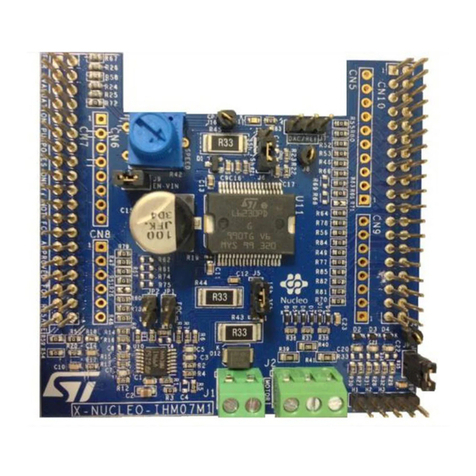
STMicroelectronics
STMicroelectronics X-NUCLEO-IHM07M1 user manual

Toshiba
Toshiba TC9349AFG manual
NXP Semiconductors
NXP Semiconductors Freescale TWR-MECH quick start guide
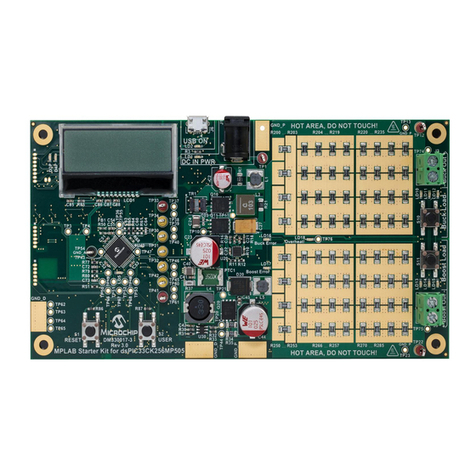
Microchip Technology
Microchip Technology Digital Power Starter Kit user guide
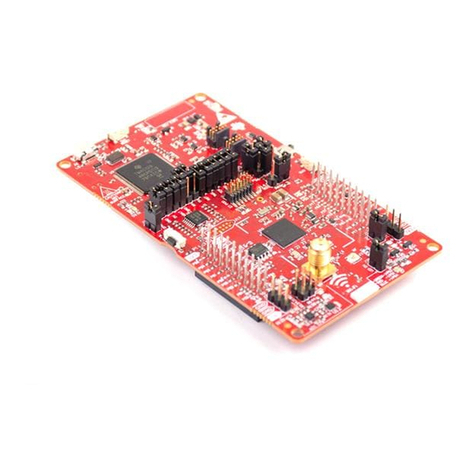
Texas Instruments
Texas Instruments CC3235 SimpleLink Series Technical reference manual
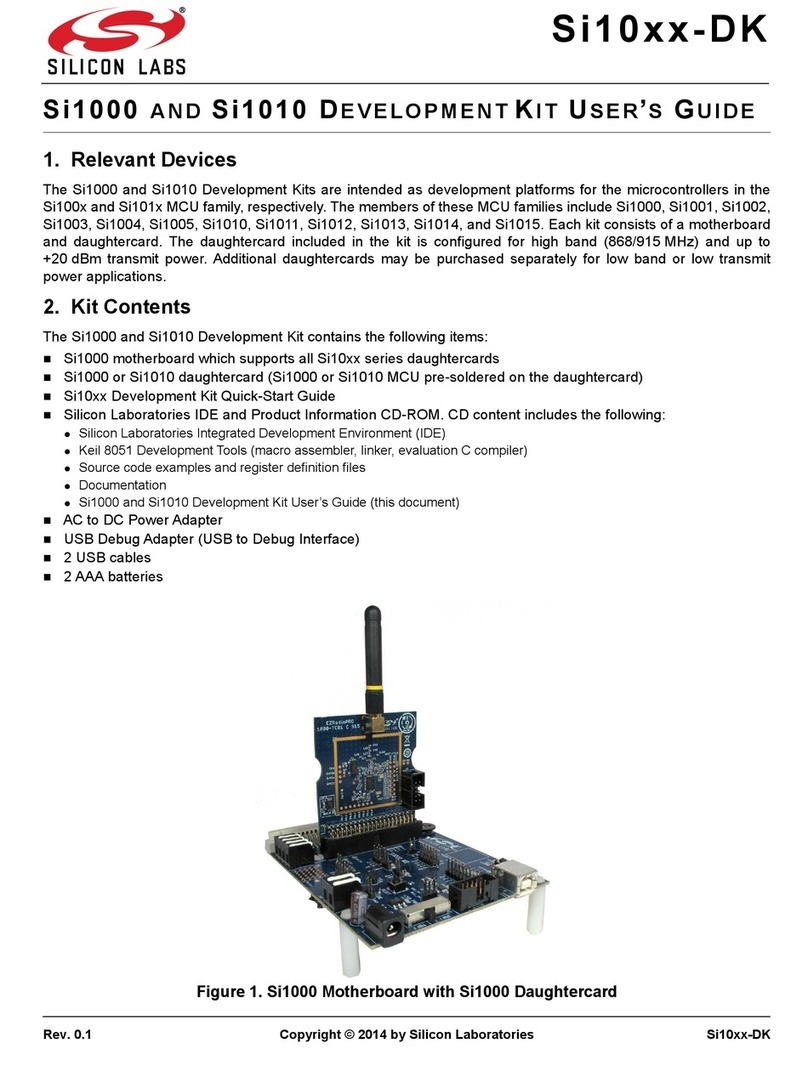
Silicon Laboratories
Silicon Laboratories Si1010 user guide
